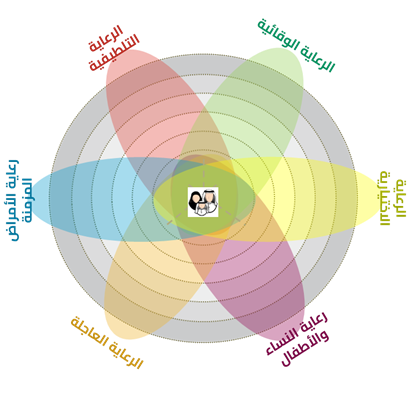Definition of the Modern Healthcare Model
The modern healthcare model represents a fundamental pillar in health transformation, as it is a model for providing integrated healthcare services to all citizens and residents in the Kingdom with the highest levels of quality and efficiency, in line with the goals of Saudi Vision 2030.
Objectives of the modern healthcare model:
- The modern healthcare model achieves the concept of "inclusiveness" in terms of disease prevention and maintains the health of individuals by adopting a preventive approach instead of a purely curative approach in providing health services.
- The model was designed and implemented in the twenty health clusters in the Kingdom to promote health and make the individual and his family partners in the responsibility of maintaining their health, reaching all levels of healthcare required by society within the health system in the Kingdom, in addition to improving the response to the health needs of the population.
A person-centered care:
- The modern healthcare model places the individual at the center of healthcare, not the facility, and provides convenient health services that are appropriate to the needs of the individual with high efficiency, distinctive quality, and high value, by exploiting digital and virtual tools, expanding the scope of community services, and enhancing the role of primary healthcare centers.
- The modern care model also provides integrated and interconnected health service paths that are centered on the individual, managed by a medical team across different service levels, and are responsible for the quality and efficiency of the service that ensures the patient’s smooth transition between different levels of health care.
How does the modern health care model work?
The modern care model operates according to six integrated care systems, followed by 42 initiatives. These systems work to reduce the incidence of disease through preventive measures and restore the individual’s health status after the disease occurs.
These systems include the following:
Preventive care:
This system focuses on prevention and health promotion, by enabling individuals to adopt healthy lifestyles and supporting communities.
Urgent care:
This system provides the necessary care in emergency cases, ensuring access to treatment at the right time and in the right place.
Elective care:
This system helps patients obtain good outcomes for scheduled medical procedures, while providing adequate care before and after the operation.
Safe childbirth:
This system ensures continuous support for mothers, from the pre-marital stage, through childbirth and post-natal care.
Chronic Disease Care:
This system focuses on providing continuous care for patients with chronic conditions, while supporting coordination between care providers to ensure quality treatment.
Palliative Care:
This system provides compassionate and supportive care to patients in the final stages of life, considering their needs and those of their families.

Healthcare Pathways:
In addition, the care model includes paths to provide healthcare at the highest levels of quality, which makes the beneficiary’s transition through the levels of care clear and specific in various service facilities from primary care centers, through general hospitals, specialized hospitals, and then medical cities.
During the past year 2023, health clusters implemented medical care paths, which include:
- Heart attacks path.
- Strokes path.
- Breast cancer screening path.
- Colorectal cancer screening path.
- Serious injuries path.
- Obesity screening path.
- Diabetes screening path.
- Hypertension path.
- Palliative care path.
- Blood lipid disorders path.
Some effects and results
- Since its implementation, the modern care model has achieved many positive results for the patient and the healthcare provider. It provides the patient with better care, higher quality, faster and safer, and enables patients to obtain better services with less effort. Patients will also be able to obtain care within primary care centers and at home as well.
- Regarding the impact of the care model on the healthcare provider, it enables him to provide high-quality and more efficient care. It also provides the optimal professional environment for the healthcare practitioner and helps employees obtain better opportunities that enable them to benefit from their skills.
- The results of implementing the modern care model in health clusters have shown important results, including reducing the duration of therapeutic intervention, reducing the waiting period for elective operations, increasing diabetes control by 70% in some health clusters, and detecting many cases of colon, rectal and breast cancer at an early stage, which contributed to the speed of providing healthcare and mitigating the effects of late diagnosis.